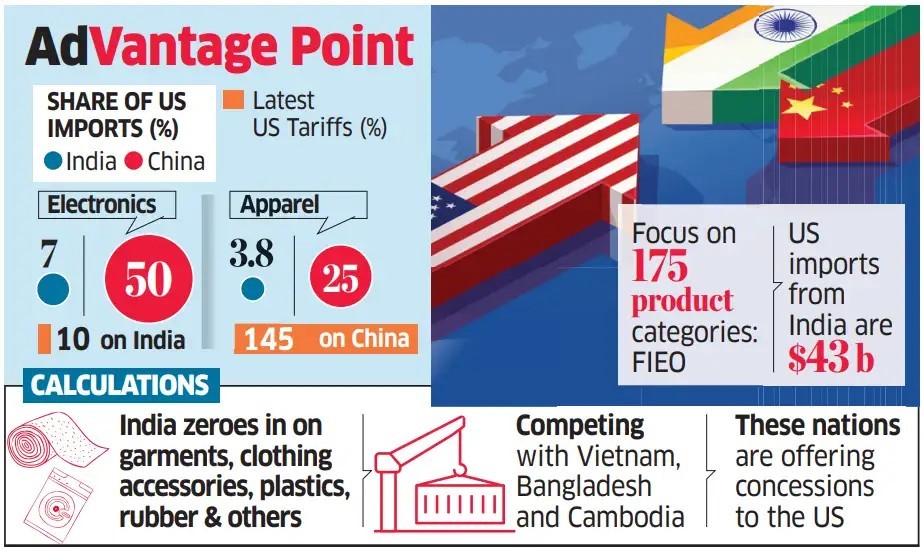India Reassesses US Market Strategy Amid China Tariffs: Implications for Indian Politics and Economy
India Reassesses US Market Strategy Amid China Tariffs: Implications for Indian Politics and Economy
Why in the News?
The US’s fresh tariff tweak on Chinese imports, including a proposed 55% levy, is prompting Indian policymakers to recalculate India’s export competitiveness. With India negotiating lower tariffs and China leveraging rare earth dominance, trade dynamics are rapidly evolving, impacting Indian politics, social justice initiatives, and the global economic landscape. These developments are particularly significant in light of ongoing discussions about the Hindu caste system and its role in shaping economic policies, as well as the representation of various ethnoreligious groups in India’s economic sphere.
Tariff Tweaks and India’s Strategic Calculations:
- The US announced a 55% tariff on Chinese goods, including pre-existing levies, raising India’s hopes of a widened tariff differential. This move has significant implications for Indian politics, with both the BJP and other parties closely monitoring its potential impact on the country’s export strategy and state representation in global trade. The situation is further complicated by the ongoing debate surrounding Hindutva and its influence on economic policies, particularly in relation to upper castes and other social groups.
- However, only 30% is newly effective, reducing the margin of benefit for Indian exporters. This development comes at a time when India is grappling with an economic slowdown and addressing caste inequalities, further complicating the country’s trade position and its efforts to uplift the middle class. The complex interplay between the Hindu caste system in Indian society and economic opportunities remains a critical factor in policy-making, with the BJP often at the center of these discussions.
- Indian policymakers expect Washington to maintain a reasonable tariff gap to favour India’s structural disadvantages like high costs, logistics issues, and infrastructure deficits. This expectation is rooted in the need for evidence-based policymaking to address India’s economic challenges and social reality, including the digital divide impact on various segments of society and ethnoreligious groups.
- Ongoing India-US trade talks may lower India’s current 26% tariff to around 10%, improving competitiveness. These negotiations are crucial for India’s economic strategy and are being closely watched by key players in Indian politics, including advocates for welfare programmes and those concerned with the list of castes in India and their representation in the economy. The BJP, in particular, is keen on ensuring that these trade negotiations benefit all sections of society, including the upper castes and OBCs (Other Backward Classes).
China’s Leverage and Rare Earth Diplomacy
- China capped rare earth magnet exports for six months, a critical input for EVs and electronics, to strengthen its position. This move has significant policy implications for global supply chains and India’s manufacturing sector, potentially affecting Scheduled Tribes and Scheduled Castes employed in these industries, as identified in previous caste-based enumeration efforts and the Socio-Economic and Caste Census (SECC).
- This move caused US manufacturers like Ford to cut production, pushing the US to negotiate. The ripple effects of this decision are likely to influence demographic shifts in manufacturing hubs across India and the US, impacting political mobilization efforts and potentially altering the dynamics of caste sociology in industrial regions. The BJP and other parties are closely monitoring these developments, considering their potential impact on various social groups, including OBCs.
- While China agreed to a “framework” in London talks, there was no official backing of Trump’s tariff claims. This diplomatic maneuvering highlights the complex interplay between trade negotiations and geopolitical strategies, with potential implications for Lok Sabha seats in trade-dependent regions, which may be subject to future delimitation processes.
- Beijing’s export restrictions have made rare earth sourcing lengthy and uncertain, raising costs for the US. This situation underscores the need for diversified supply chains and could potentially exacerbate the north-south divide in global manufacturing capabilities, affecting India’s efforts to address caste inequalities and the concerns of lower OBCs.
Uncertainty in Trade Talks and Future Outlook
- Two rounds of talks (Geneva & London) reflect US concessions and China’s growing influence in the bilateral dialogue. These developments are reshaping global trade dynamics and could have far-reaching consequences for India’s economic policies and social justice initiatives, including ongoing debates about reservation demands and the need for updated OBC data.
- The US has been requesting relief from Chinese restrictions amid domestic economic pressures like price surges. This scenario presents both challenges and opportunities for India’s export sector and overall economic strategy, particularly in relation to the upcoming Census 2026-27 and its potential impact on policy formulation. The question of “When is the census?” has become increasingly important, as the census definition and enumeration date will be crucial in determining the accuracy of population count and reference date for future policies.
- India remains watchful as tariff advantages may shrink if the US reduces duties on China further. This situation requires careful analysis and strategic planning in Indian politics to navigate the evolving global trade landscape and its effects on state representation in international markets. The analysis will likely draw on data from the 2011 census and the Socio-Economic and Caste Census (SECC) to inform decision-making, with particular attention to OBC data and its implications for economic policies.
- Overall, China’s rare earth dominance is reshaping global supply chains and policy strategies. This shift necessitates a reevaluation of India’s economic policies and could influence future electoral politics as parties position themselves on trade and economic issues, potentially affecting the distribution of Lok Sabha seats based on updated demographic data.
In conclusion, the complex interplay of US-China trade relations, rare earth diplomacy, and global economic shifts presents both challenges and opportunities for India. As the country navigates these turbulent waters, the decisions made in the realm of trade policy are likely to have significant implications for Indian politics, economic growth, and India’s position in the global economy. The BJP and other political parties will need to address these issues while balancing the needs of the middle class, welfare programmes, and efforts to reduce caste inequalities.
The upcoming Census 2026-27 may provide crucial data to inform these decisions and shape India’s future trade strategies, with caste data collection playing a vital role in understanding the socio-economic landscape of the country. This census will be particularly important in light of historical precedents, such as the 1931 census, which was the last to collect comprehensive caste data. The new census will need to address challenges such as census participation rates and the collection of language data in census, which are crucial for understanding India’s diverse social fabric.
Moreover, the ongoing debates surrounding anti-Muslim prejudice and its potential impact on economic policies cannot be ignored. As India strives to position itself in the global market, it must also address internal social challenges, including those stemming from the historical Mandal upsurge, which brought caste-based reservations to the forefront of Indian politics. The BJP, as the ruling party, faces the complex task of balancing economic growth with social justice, ensuring that the benefits of international trade reach all segments of society, including the upper castes, OBCs, and other marginalized groups.






